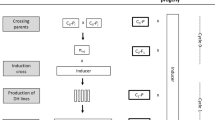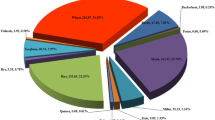Summary
Dominant alleles of the Kr1 and Kr2 genes reduce the crossability of hexaploid wheat with many alien species, including rye and Hordeum bulbosum, with Kr1 having the greater effect. However, a cytological study of wheat ovaries fixed 48 h after pollination showed that the wheat genotypes ‘Highbury’ (kr1, Kr2) and ‘Chinese Spring (Hope 5B)’ (kr1, kr2) were crossable with ‘Seneca 60’ maize, fertilization occurring in 14.4 and 30.7% of embryo sacs respectively. The latter figure was similar to the 29.7% fertilization found in ‘Chinese Spring’ (kr1, kr2). Most embryo sacs in which fertilization occurred contained an embryo but lacked an endosperm and where an endosperm was formed it was usually highly aberrant. All three wheat x maize combinations were karyotypically unstable and rapidly eliminated maize chromosomes to produce haploid wheat embryos.
Similar content being viewed by others
References
Barclay IR (1975) High frequencies of haploid production in wheat (Triticum aestivum) by chromosome elimination. Nature 256:410–411
Bennett MD (1977) Heterochromatin, aberrant endosperm nuclei and grain shrivelling in wheat-rye genotypes. Heredity 39:411–419
Bennett MD, Smith JB (1976) Nuclear DNA amounts in angiosperms. Philos Trans Roy Soc London, Ser B 274:227–274
Bennett MD, Rao MK, Smith JB, Bayliss MW (1973) Cell development in the anther, the ovule, and the young seed of Triticum aestivum L. var. ‘Chinese Spring”. Philos Trans Roy Soc London, Ser B 266:38–81
Falk DE, Kasha KJ (1981) Comparison of the crossability of rye (Secale cereale) and Hordeum bulbosum onto wheat (Triticum aestivum). Can J Genet Cytol 23:81–88
Falk DE, Kasha KJ (1983) Genetic studies of the crossability of hexaploid wheat with rye and Hordeum bulbosum. Theor Appl Genet 64:303–307
Finch RA, Bennett MD (1982) Preferential survival of wheat haploids over hybrids in a wheat X barley cross. Heredity 48:293–298
Finch RA, Bennett MD (1983) The mechanism of somatic chromosome elimination in Hordeum. In: Brandham PE, Bennett MD (eds) Kew Chromosome Conference II. Allen and Unwin, London, pp 147–154
Furuta Y, Nishikawa K, Makino T, Sawai Y (1984) Variation in DNA content of 21 individual chromosomes among six subspecies in common wheat. Jpn J Genet 59:83–90
Ho KM, Kasha KJ (1975) Genetic control of chromosome elimination during haploid formation in barley. Genetics 81:263–275
Jalani BS, Moss JP (1980) The site of action of the crossability genes (kr1, Kr2) between Triticum and Secale. 1. Pollen germination, pollen tube growth, and number of pollen tubes. Euphytica 29:571–579
Kaltsikes PJ, Roupakias DG, Thomas JB (1975) Endosperm abnormalities in Triticum-Secale combinations. 1. Triticosecale and its parental species. Can J Bot 53:2050–2067
Kasha KJ, Reinbergs E (1981) Recent developments in the production and utilization of haploids in barley. In: Asher MJC (ed) Barley genetics, vol IV. Proc 4th Int Barley Genet Symp. Edinburgh, pp 655–665
Krolow KD (1970) Untersuchungen über die Kreuzbarkeit zwischen Weizen und Roggen. Z Pflanzenzücht 64:44–72
Lange W, Riley R (1973) The position on chromosome 5B of wheat of the locus determining crossability with rye. Genet Res 22:143–153
Lange W, Wojciechowska B (1976) The crossing of common wheat (Triticum aestivum L.) with cultivated rye (Secale cereale L.). 1. Crossability, pollen grain germination and pollen tube growth. Euphytica 25:609–620
Laurie DA, Bennett MD (1985) Nuclear DNA content in the genera Zea and Sorghum. Intergeneric, interspecific and intraspecific variation. Heredity 55:307–313
Laurie DA, Bennett MD (1986) Wheat X maize hybridization. Can J Genet Cytol 28:313–316
Lein A (1943) Die genetische Grundlage der Kreuzbarkeit zwischen Weizen und Roggen. Z Indukt Abstamm-Vererbungsl 81:28–61
Pickering RA (1983) The influence of genotype on doubled haploid production. Euphytica 32:863–876
Pickering RA (1984) The influence of genotype and environment on chromosome elimination in crosses between Hordeum vulgare L. x Hordeum bulbosum L. Plant Sci Lett 34:153–164
Riley R, Chapman V (1967) The inheritance in wheat of crossability with rye. Genet Res 9:259–267
Simpson E, Snape JW, Finch RA (1980) Variation between Hordeum bulbosum genotypes in their ability to produce haploids of barley, Hordeum vulgare. Z Pflanzenzücht 85:205–211
Sitch LA (1984) The production and utilization of wheat doubled haploids. PhD Thesis, University of Cambridge
Sitch LA, Snape JW, Firman SJ (1985) Intrachromosomal mapping of crossability genes in wheat (Triticum aestivum). Theor Appl Genet 70:309–314
Snape JW (1982) The use of doubled haploids in plant breeding. In: Induced variability in plant breeding. PUDOC, Wageningen, pp 52–58
Snape JW, Bennett MD, Simpson E (1980) Post-pollination events in crosses of hexaploid wheat with tetraploid Hordeum bulbosum. Z Pflanzenzücht 85:200–204
Snape JW, Chapman V, Moss J, Blanchard CE, Miller TE (1979) The crossabilities of wheat varieties with Hordeum bulbosum. Heredity 42:291–298
Tanner DG, Falk DE (1982) The interaction of genetically controlled crossability in wheat and rye. Can J Genet Cytol 23:27–32
Zenkteler M, Nitzsche W (1984) Wide hybridization experiments in cereals. Theor Appl Genet 68:311–315
Author information
Authors and Affiliations
Additional information
Communicated by R.Riley
Rights and permissions
About this article
Cite this article
Laurie, D.A., Bennett, M.D. The effect of the crossability loci Kr1 and Kr2 on fertilization frequency in hexaploid wheat x maize crosses. Theoret. Appl. Genetics 73, 403–409 (1987). https://doi.org/10.1007/BF00262508
Received:
Accepted:
Issue Date:
DOI: https://doi.org/10.1007/BF00262508




